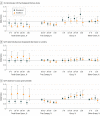Association of Urban Green Space With Mental Health and General Health Among Adults in Australia
- PMID: 31348510
- PMCID: PMC6661720
- DOI: 10.1001/jamanetworkopen.2019.8209
Association of Urban Green Space With Mental Health and General Health Among Adults in Australia
Abstract
Importance: Recent studies indicate that living near more green space may support mental and general health and may also prevent depression. However, most studies are cross-sectional, and few have considered whether some types of green space matter more for mental health.
Objective: To assess whether total green space or specific types of green space are associated with better mental health.
Design, setting, and participants: This cohort study included a residentially stable, city-dwelling sample of 46 786 participants from Sydney, Wollongong, and Newcastle, Australia, in the baseline of the Sax Institute's 45 and Up Study (data collected from January 1, 2006, to December 31, 2009). Follow-up was conducted from January 1, 2012, to December 31, 2015. Analyses were conducted in January 2019.
Exposures: Percentage of total green space, tree canopy, grass, and other low-lying vegetation measured within 1.6-km (1-mile) road network distance buffers around residential addresses at baseline.
Main outcomes and measures: Three outcome variables were examined at baseline (prevalence) and follow-up (incidence without baseline affirmatives): (1) risk of psychological distress (10-item Kessler Psychological Distress Scale), (2) self-reported physician-diagnosed depression or anxiety, and (3) fair to poor self-rated general health.
Results: This study included 46 786 participants (mean [SD] age, 61.0 [10.2] years; 25 171 [53.8%] female). At baseline, 5.1% of 37 775 reported a high risk of psychological distress, 16.0% of 46 786 reported depression or anxiety, and 9.0% of 45 577 reported fair to poor self-rated health. An additional 3.3% of 32 991 experienced psychological distress incidence, 7.5% of 39 277 experienced depression or anxiety incidence, and 7.3% of 40 741 experienced fair to poor self-rated health incidence by follow-up (mean [SD] of 6.2 [1.62] years later). Odds ratios (ORs) adjusted for age, sex, income, economic status, couple status, and educational level indicated that exposures of 30% or more total green space (OR, 0.46; 95% CI, 0.29-0.69) and tree canopy specifically (OR, 0.69; 95% CI, 0.54-0.88) were associated with lower incidence of psychological distress. Exposure to tree canopy of 30% or more, compared with 0% to 9%, was also associated with lower incidence of fair to poor general health (OR, 0.67; 95% CI, 0.57-0.80). Exposure to grass of 30% or more, compared with 0% to 4%, was associated with higher odds of incident fair to poor general health (OR, 1.47; 95% CI, 1.12-1.91) and prevalent psychological distress (OR, 1.71; 95% CI, 1.25-2.28). Exposure to low-lying vegetation was not consistently associated with any outcome. No green space indicator was associated with prevalent or incident depression or anxiety.
Conclusions and relevance: Protection and restoration of urban tree canopy specifically, rather than any urban greening, may be a good option for promotion of community mental health.
Conflict of interest statement
Figures

Comment in
-
Comparison of the Health Benefits of Different Types of Nature.JAMA Netw Open. 2019 Jul 3;2(7):e198215. doi: 10.1001/jamanetworkopen.2019.8215. JAMA Netw Open. 2019. PMID: 31348502 No abstract available.
References
-
- World Health Organization Mental Health Action Plan 2013–2020. Geneva, Switzerland: World Health Organization; 2013.
-
- Mair C, Diez Roux AV, Galea S. Are neighbourhood characteristics associated with depressive symptoms? a review of evidence. J Epidemiol Community Health. 2008;62(11):-. - PubMed
-
- World Health Organization Urban Green Spaces and Health: A Review of Evidence. Copenhagen, Denmark: World Health Organization Regional Office for Europe; 2016.

